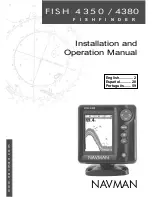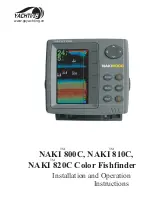
6.3 Sonar troubleshooting
Problems with the sonar and their possible causes and solutions are described here.
Problem
Possible causes
Possible solutions
Unit power supply fault.
Check the unit power supply and cables.
Other unit fault.
Refer to the instructions supplied with the unit.
Check that the unit is correctly connected to a Raymarine
network switch. If a crossover coupler or other coupler
cable / adapter is used, check all connections (as
applicable).
Check the status of the Raymarine network switch (if
applicable).
SeaTalk
hs
/ RayNet network
problem.
Check that SeaTalk
hs
/ RayNet cables are free from
damage.
Sonar data not available on
multifunction display.
Software mismatch between
equipment may prevent
communication.
Contact Raymarine technical support.
Gain or Frequency settings may
be inappropriate for present
conditions.
Check the sonar presets, gain and frequency settings.
Unit power supply fault.
Check the voltage from the power supply, if this is too low
it can affect the transmitting power of the unit.
Unit cable fault.
Ensure that the power, transducer and all other cables to
the unit are properly connected and free from damage.
Check that the transducer is mounted correctly and is
clean.
Transducer fault.
If you have a transom mount transducer, check that the
transducer hasn't kicked-up due to hitting an object.
Other unit fault.
Refer to the instructions supplied with the unit.
Vessel stationary.
Fish arches are not displayed if the vessel is stationary;
fish will appear on the display as straight lines.
High vessel speed
Turbulence around the transducer may be confusing the
unit.
Problematic data readings.
Note:
Not
all
transducers
and
/
or
sonar
modules
support
the
detection
of
depth,
range
and
temperature.
For
more
information,
refer
to
the
latest
specifications
and
documentation
available
for
your
particular
products.
Scroll speed set to zero
Adjust the scroll speed.
System checks and troubleshooting
































